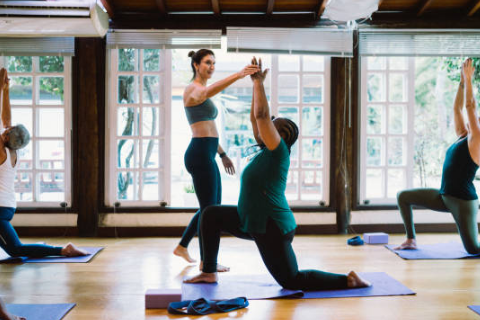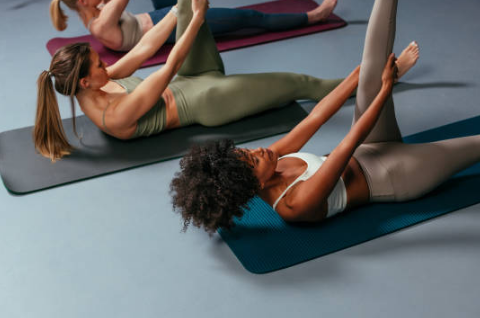Both Pilates and yoga can build strength, improve flexibility, and enhance balance—but they have different goals.
Pilates focuses on flexibility, strength, and pain relief. Yoga emphasizes the mind-body connection while also boosting flexibility and strength.
Which one suits you best depends on your health goals and personal preferences. A healthcare provider can help you choose based on your fitness and health status.
Choosing Between Pilates and Yoga
Both are low-impact bodyweight exercises with many health benefits—they’re excellent for improving flexibility, building strength, and reducing pain. Your choice should be based on your goals, what classes are available, and cost.
-
Choose Pilates if you want better posture, stronger core muscles, or recovery from injuries.
-
Choose Yoga if you’re seeking a deeper mind-body connection, increased flexibility, and improved balance.
-
Yoga Styles: For example, faster-paced styles like Vinyasa (flow) can also support cardiovascular fitness.

How They’re Practiced
Pilates was developed by Joseph Pilates in the early 20th century for injured soldiers and athletes, and later adopted by dancers. The goal is to strengthen the core muscles and stabilize the spine. You can do it on a mat or with a Pilates “Reformer”—a spring-equipped machine that lets your body move with controlled resistance.
Yoga is an ancient practice that combines postures, breathing exercises, and meditation. It not only strengthens the body but fosters a strong mind-body connection. Yoga requires minimal equipment—just a mat—though props like blocks can help with poses.
Movements and Techniques
Both Pilates and yoga are accessible to people of all ages, body types, and fitness levels. They require little to no equipment and improve balance, core strength, and flexibility—but their practices differ.
Yoga
There are over 13 types of yoga, including:
-
Hatha
-
Vinyasa (flow)
-
Hot yoga (like Bikram)
-
Prenatal yoga
Yoga combines poses and breathing in a rhythmic flow. You can practice on your own at home or join certified classes.
Popular poses include:
-
Cat-Cow: On hands and knees, alternate arching your spine up (like a cat) and sinking it down (like a cow), stretching the spine and warming up the back.
-
Downward-Facing Dog: A V-shaped pose that stretches the hamstrings, calves, and shoulders while engaging the core and supporting the back.
-
Child’s Pose: Kneel, sit on your heels, spread your knees, and fold forward—forehead to mat, arms extended. It’s a restorative pose that eases back, hip, and thigh tension.
Pilates
You can practice Pilates through online apps or attend mat or Reformer classes where instructors teach proper alignment. Many studios offer beginner Reformer classes.
Two popular Pilates exercises:
-
The Hundred: A dynamic warm-up targeting the abs and lungs. You pump your arms up and down 100 times while legs stay extended and shoulders lifted.
-
The Bridge: Lie on your back, lift your hips, keeping shoulders and feet grounded. It targets glutes, hamstrings, inner thighs, and obliques. You can add variations like lowering hips, lifting heels, or raising one leg at a time.
Health Benefits
Both yoga and Pilates enhance flexibility and strength, support better movement, and reduce pain—benefiting both physical and emotional well-being.

Yoga Benefits:
-
Increases range of motion and balance through combines stretching and breath-work.
-
Reduces depression, stress, and anxiety.
-
Alleviates chronic back pain when poses are done correctly.
-
Lessens tension headaches in frequency and duration.
-
A study of 60 overweight or obese women found long-term weight loss benefits tied to yoga—improvements in mindfulness, self-compassion, and stress regulation outpaced those from diet-only weight loss.
Pilates Benefits:
-
Developed to assist recovery, it improves function, balance, and strength.
-
Strengthens core and improves posture—two Pilates sessions per week for three months helped women with lower-body strength and postural balance.
-
Enhances quality of life—women practicing Pilates twice weekly for six months experienced notable improvements.
-
Reduces anxiety and fatigue while boosting energy.
-
Helps control pain from fibromyalgia and osteoarthritis. Pregnant women attending two Pilates sessions per week showed better labor outcomes, lower blood pressure, and better flexibility.
Safety Considerations
Pilates and yoga are generally safe, low-impact activities. To avoid injury and get the most benefit:
-
Talk to your healthcare provider to ensure these are safe for you.
-
Choose a class level that matches your fitness level, preferably with a certified instructor if you’re a beginner.
-
Stay hydrated before, during, and after.
-
Start slowly and listen to your body—stop if you feel pain.
Both yoga and Pilates offer excellent options to improve strength, flexibility, and overall wellbeing. Picking the right one depends on your goals—be it a stronger core, a quieter mind, or deeper flexibility.

